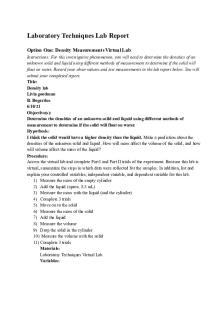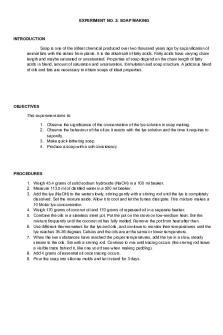Skin and Sensation Full Laboratory Report PDF

| Title | Skin and Sensation Full Laboratory Report |
|---|---|
| Course | General Physiology |
| Institution | De La Salle University – Dasmariñas |
| Pages | 6 |
| File Size | 504.6 KB |
| File Type | |
| Total Downloads | 40 |
| Total Views | 142 |
Summary
Skin and Sensation Full Laboratory Report...
Description
GENERAL PHYSIOLOGY LABORATORY Module 7.0: Activity 6: Skin and Sensation Physiology
Enabling Assessment 6
Activity 6: Skin and Sensation Physiology
Name
Date
Teacher Points
Sir Louis Alexiz Urbina 60 points
Time Allotment
90 minutes
06
21
CYS
2
Score
I. Results and Discussion: 1. Write the results of the measured two-point sensibility for each part (millimeters, mm): a. Back of the neck or nape area b. Fingertip c. Forearm (supine position) d. Tip of nose e. Palm of hand f. Tongue g. Upper arm h. Thigh area i. Leg area
____9____mm ____1____mm ____6____mm ____2____mm ____4____mm ____2____mm ____5____mm ____6____mm ____5____mm
2. Account for the touch receptors’ density of distribution in the given various areas in relation to the distinction of two-points. Which of the following body areas is the most sensitive? Why? Based on the distinction of two-points, it can be observed that the fingertip is the most sensitive. This can be attributed to the abundance of sensory neurons in the aforementioned areas. There is a larger brain area devoted to receiving sensory neurons' messages when an area contains more sensory neurons, implying more sensitivity. According to the first map generated by scientists showing how pain sensitivity varies across the human body, the fingertips, along with the forehead, are the most sensitive. 3. Tactile localization. Complete the table (millimeters, mm): Body area
a. Palm b. Fingertips c. Forearm (dorsal side)
Trial 1 (distance localization
Trial 2 (distance localization)
2.54 0 8.4
5.3 0 15
Error of localization (T2T1) in millimeters 2.76 0 6.6
Page | 1
GENERAL PHYSIOLOGY LABORATORY Module 7.0: Activity 6: Skin and Sensation Physiology
d. Forearm (ventral side) e. Lips f. Thigh region
7.1
8.3
1.2
0 13.4
0 16.5
0 3.1
4. Adaptation of Touch Receptors (coin model). Complete the table: Right forearm (sec.)
Left Forearm (sec.)
Single coin = 6.2 Doubled coin =10.5
Single coin = 5.1 Doubled coin =8.8
Difference of time in distinction (sec.) Single coin =1.10 Doubled coin = 1.70
5. Does the sense of pressure become shorter or longer after the addition of coins? Why? The sense of pressure becomes longer after the addition of coins. When a constant stimulus is supplied to a sensory receptor, it responds best initially, but eventually, the response tends to decrease. Touch receptors gradually adapt to constant pressure by ceasing to deliver pressure signals to the brain. 6. What type of receptors are involved in adaptation of touch receptors? What is sensory adaptation? Does variation in ability to adapt occur among receptors? The type of receptors that are involved in the adaptation of touch receptors is the Pacinian corpuscles, which detect deep pressure and vibration by being compressed which stimulates their internal dendrites. Sensory adaptation is a phenomenon that occurs when sensory receptors are subjected to stimuli. Depending on the stimuli, receptors may increase or decrease their ability to respond, resulting in increased or decreased sensitivity to the stimuli. Yes, receptors’ ability to adapt vary. Rapidly adapting, or phasic, receptors such as the Pcinian corpuscle respond maximally but briefly to stimuli; if the stimulus is prolonged, their response declines. Slowly adapting, or tonic, receptors such as pain receptors on the other hand, continue to fire as long as the stimulus is present. 7. How does brain information happen upon adaptation of a receptor by a stimulus? Each neurotransmitter is set up to react to specific stimuli. They have receptors that sense signaling chemicals and send quick responses to the brain in order to do so. The receptors go through a quick adaptation period after receiving a stimulation, during which the receptor decreases its depolarization. This reduces the frequency of signals sent to the brain by this receptor, signaling to the brain that adaptation is occurring.
Page | 2
GENERAL PHYSIOLOGY LABORATORY Module 7.0: Activity 6: Skin and Sensation Physiology
Basically, when a receiver adapts to a stimulus, the polarization of the receiver decreases. This results in a reduction in frequencies that reach the brain, signaling to the brain that the receptor is in the process of adapting. 8. Intensity Difference using Weber’s Fraction. Complete the table below: Initial Weight Intensity (I) 10 grams
Intensity Difference ( I) in grams (g) 24
Weber’s Fraction ( I/I)
50 grams
12
12/50=0.24
100 grams
6
6/100=0.06
200 grams
3
3/200=0.015
24/10= 2.4
9. Account for the ratio of each given trial (Weber’s fraction) in relation to the initial weight. It is assumed that Weber’s law is applicable only to weights in the medium range. According to Weber's law, the size of the just visible difference is a constant proportion of the original stimulus magnitude in this table. It can be observed that as the initial weight increases, the weber’s fraction decreases. It exhibits an inverse relationship which can be attributed to the fact that according to Weber's law, the only perceptible change in a stimulus is a constant ratio of the original stimulus.If the strength of a sensation is doubled from its initial value and the sensation is noticed, the intensity must be doubled again to produce the same impression of increased experience. The just-noticeable difference (JND) is also included in Weber's law. This is the tiniest change in stimuli that may be perceived by the subject. Weber's law invariably fails at low intensities, close and below the absolute detection threshold, and frequently also at high levels, but it may be roughly valid over a wide middle range of intensities. 10. Give the significance of Weber’s law. Humans have highly evolved sensory faculties that allow us to comprehend the kaleidoscope of sights, sounds, scents, and tastes in our environment. People are extremely adept at making use of the large amount of information available to them because the human perceptual system is designed for precision. Weber's law, also known as Weber-Fechner law, quantifies a stimulus' perception of change, stating that the ability to detect changes is influenced by the size of the difference in relation to the absolute size of the stimulus, rather than the magnitude of the difference itself. In the modern day, Weber's research has enhanced our knowledge of touch and bodily experiences. Weber conducted research on body sensations to show that physical sensations Page | 3
GENERAL PHYSIOLOGY LABORATORY Module 7.0: Activity 6: Skin and Sensation Physiology
and judgments are linked. As a result, Weber's law made an important contribution to experimental psychology. 11. With hands in each beaker, which hand adapts faster the colder or the warmer hand? Why? When you first submerge your right hand in cold water, cold thermoreceptors in your hand activate, rapidly depolarize, then adjust to a steady-state level that is still depolarized, sending instructions to your brain that allow you to identify the water as "cold." Warm thermoreceptors activate when the left hand is immersed in hot water. Warm receptors, on the other hand, rapidly hyperpolarize before adjusting to a slightly hyperpolarized state, allowing you to recognize the water in this pot as "warm." After a period, the thermoreceptors in your palms became less active. They'd been desensitized, and the water in their various pots didn't seem cold or hot anymore. 12. Which hand adapts faster in room temperature water? Why? Your hands experienced the room-temperature water differently, which perplexed you. Your brain received conflicting signals from the temperature of the water in the roomtemperature container. This experiment reveals how your sense of temperature is influenced by your previous environment. When you move your hand from cold to warm water, your cold receptors (which are already partially depolarized) do not respond as strongly. Warm receptors do, and the response is higher than typical because they are slightly hyperpolarized. The brain perceives warm water as hot because hot receptors receive more information than cold receptors. 13. Referred Pain: Describe the sensation felt after 2 to 3 minutes? Does the sensation travel to another location? Why? Because blood stays close to your organs to preserve heat, your veins tighten and less blood flows to your extremities. This indicates that your skin is stiffer than usual, potentially putting additional strain on your already sensitive nerves. When the subject's elbow was submerged or placed in a pail of ice water, he felt discomfort in his hand. The Ulnar nerve is located in your elbow, and when it is soaked in cold water, the pain felt in your elbow goes up your arm and into your hand. the distance from the source of the pain trigger. The discomfort is felt in the hand rather than the elbow, even though the hand is not in the frigid water. This is the mechanism of referred pain, which is pain that is felt in a separate part of the body. 14. What is referred pain? What is its mechanism? Referred pain occurs when pain in one region of your body is triggered by pain or damage in another part of your body. Multiple primary sensory neurons converging on a single ascending tract causes referred pain. Nerve fibers from the upper region of the spinal cord, such as the skin, and nerve fibers from the lower region, such as the stomach, converge at the same level of the spinal cord. This can lead to confusion about where the feeling/pain is originating from, as stimuli from lower Page | 4
GENERAL PHYSIOLOGY LABORATORY Module 7.0: Activity 6: Skin and Sensation Physiology
sensory inputs to the brain might be misinterpreted as coming from higher regions, resulting in the pain sensation being positioned along a corresponding dermatome of the same spinal segment. 15. Give the significance of referred pain. The brain constantly receives information from sensory neurons and adaptation is important simply because it protects the nervous system from being inundated with irrelevant information. In clinical terms, referred pain can be a sign of nerve injury or a sign of something more serious going on in a person's body. It's critical to comprehend how and why this occurs. For example, referred pain contributes to the pain of myogenic headaches. Another more prevalent example is when a person has a heart attack, which is a common cause of referred pain in the patient's jaw, teeth, and shoulders. When the body reacts to a blockage in the heart valves, which can lead to a heart attack, pain arises. For this reason, assessing referred pain during the initial evaluation of patients can be crucial for proper diagnosis and therapy.
Page | 5
GENERAL PHYSIOLOGY LABORATORY Module 7.0: Activity 6: Skin and Sensation Physiology
III. Conclusion: The somatosensory system, a vast network of nerve endings and touch receptors in the skin, controls our perception of touch. Tactile localization refers to a person's capacity to pinpoint the exact location of tactile stimulus. Sensory adaptation happens when the sensory receptors are exposed to stimuli for an extended period of time. Receptors may increase or decrease their ability to respond, resulting in increased or lessened sensitivity to the stimuli, depending on the stimuli. Through the conducted experiments, relative sensitivities of various areas of the skin have been observed. The skin is the largest organ and plays a vital role in numerous functions such as detecting hot and cold, touch reception, and generally protecting us from external stimuli that may cause us harm.
IV. References: Creation – Understanding the Human. History of Theories in Psychology PSYC 493 Creation Understanding the Human Comments. (n.d.). https://blogs.acu.edu/1410_PSYC49301/2013/10/18/creation-understanding-the-human/. Encyclopædia Britannica, inc. (n.d.). Weber's law. Encyclopædia Britannica. https://www.britannica.com/science/Webers-law. Guardian News and Media. (2014, June 5). Forehead and fingertips most sensitive to pain, research shows. The Guardian. https://www.theguardian.com/science/2014/jun/06/forehead-and-fingertips-most-sensitive-first-pain-map-shows. Henrichon, S. J. (2019, March 2). Examples of Sensory Adaptation. Sciencing. https://sciencing.com/examples-sensory-adaptation14224.html. Learning, L. (n.d.). Introduction to Psychology. Lumen. https://courses.lumenlearning.com/wmopen-psychology/chapter/readingtouch-andpain/#:~:text=Touch%2C%20Thermoception%2C%20and%20Noiception,Merkel's%20disks%2C%20and%20Ruffini%20corp uscles. Lous, I. (2005, June 23). THE IMPORTANCE OF REFERRED PAIN IN MYOGENIC HEADACHE. American Headache Society. https://headachejournal.onlinelibrary.wiley.com/doi/abs/10.1111/j.1526-4610.1976.hed1603119.x. Modalities of Sensation - Nociceptors - Hyperalgesia. TeachMePhysiology. (2021, March 30). https://teachmephysiology.com/nervous-system/sensory-system/modalities-of-sensation/. Purves D, Augustine GJ, Fitzpatrick D, et al., editors. Neuroscience. 2nd edition. Sunderland (MA): Sinauer Associates; 2001. Cutaneous and Subcutaneous Somatic Sensory Receptors. Available from: https://www.ncbi.nlm.nih.gov/books/NBK11162/ Referred Pain. Physiopedia. (n.d.). https://www.physio-pedia.com/Referred_Pain. Skin Labs. prezi.com. (n.d.). https://prezi.com/njyg5qce6z-c/skin-labs/?frame=e79b3dbca05ad11cf24a75941237a3550498f14d. U.S. National Library of Medicine. (n.d.). Home - Books - NCBI. National Center for Biotechnology Information. https://www.ncbi.nlm.nih.gov/books. Watson, K. (2019, October 29). Referred Pain: Common Areas and What It Means. Healthline. https://www.healthline.com/health/pain-relief/referred-pain#causes. Yuhas, D. (2012, May 31). Skin-Deep Science: Find Your Sensitive Side. Scientific American. https://www.scientificamerican.com/article/bring-science-home-sensitiveskin/#:~:text=The%20reason%20you%20are%20more,their%20signals%2C%20meaning%20more%20sensitivity.
Page | 6...
Similar Free PDFs

Skin Lab Report
- 6 Pages

Full Report
- 16 Pages

FULL Report
- 23 Pages

Lab 1 - Laboratory Report
- 10 Pages

Laboratory+report+1-4
- 11 Pages

Laboratory 11 - Lab Report
- 3 Pages

Laboratory report - aspirin
- 8 Pages

Laboratory Report 1 SKO3023
- 30 Pages

Sensation and Perception
- 42 Pages

Laboratory Report Rubric
- 2 Pages

Laboratory Techniques Lab Report
- 4 Pages

LABORATORY REPORT EXPERIMENT 5
- 6 Pages
Popular Institutions
- Tinajero National High School - Annex
- Politeknik Caltex Riau
- Yokohama City University
- SGT University
- University of Al-Qadisiyah
- Divine Word College of Vigan
- Techniek College Rotterdam
- Universidade de Santiago
- Universiti Teknologi MARA Cawangan Johor Kampus Pasir Gudang
- Poltekkes Kemenkes Yogyakarta
- Baguio City National High School
- Colegio san marcos
- preparatoria uno
- Centro de Bachillerato Tecnológico Industrial y de Servicios No. 107
- Dalian Maritime University
- Quang Trung Secondary School
- Colegio Tecnológico en Informática
- Corporación Regional de Educación Superior
- Grupo CEDVA
- Dar Al Uloom University
- Centro de Estudios Preuniversitarios de la Universidad Nacional de Ingeniería
- 上智大学
- Aakash International School, Nuna Majara
- San Felipe Neri Catholic School
- Kang Chiao International School - New Taipei City
- Misamis Occidental National High School
- Institución Educativa Escuela Normal Juan Ladrilleros
- Kolehiyo ng Pantukan
- Batanes State College
- Instituto Continental
- Sekolah Menengah Kejuruan Kesehatan Kaltara (Tarakan)
- Colegio de La Inmaculada Concepcion - Cebu



